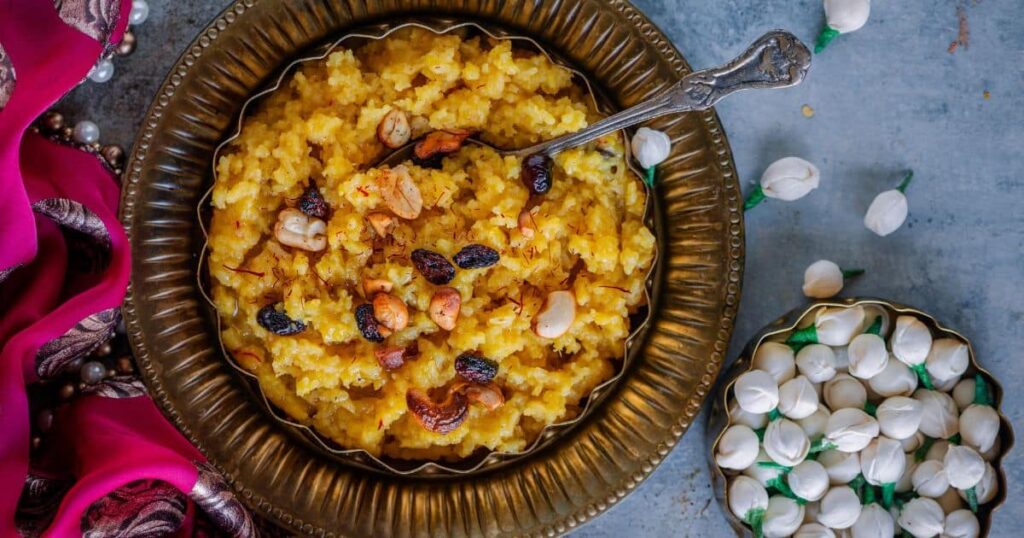As an additional step, you can dry roast the rice and moong dal before rinsing them to enhance their flavor. The ideal ratio of rice to yellow dal is 4:1. Sakkarai Pongal is considered well done when the rice and lentils are no longer distinguishable, becoming soft, mushy, and homogenous. If the mixture seems too thick, simply add some water, mix, and simmer for a couple of minutes.
If you prefer to make Pongal without milk, feel free to skip it and use only water. Be generous with the ghee—the more you add, the better the flavor. The sweetness of this Sweet Pongal is balanced, but if you prefer a sweeter taste, add 50 grams of jaggery. For added convenience, you can divide the cooked rice and moong dal in half to make both savory and Sweet Pongal at the same time.
You can substitute rice in Pongal with options like red rice, brown rice, wheat rava, broken wheat (dalia), poha, oats, quinoa, or millets (such as in Quinoa Khichdi). When substituting, make sure to adjust the water quantity as needed, as different grains absorb water at different rates. For lentils, moong dal can be replaced with chana dal or tur dal. These substitutes will alter the texture and flavor of the dish slightly but will still result in a delicious variation.
To make Vegan Sweet Pongal, start by skipping any milk and cooking the rice and yellow lentils with only water. If you prefer a creamier texture, you can opt for dairy-free milk alternatives such as almond milk, cashew milk, thinned-down coconut milk, or oat milk. For the ghee, substitute it with vegan ghee, vegan butter, or any neutral vegetable oil to keep the dish entirely plant-based. Follow the rest of the recipe as usual, ensuring all ingredients are plant-based for a delicious vegan version of this traditional sweet Pongal.
To store leftover Sakkara Pongal, allow it to cool to room temperature. When it’s hot, it will have a semi-solid consistency, but it will solidify as it cools. If it becomes too firm, use a spoon to scoop it out. You can store it at room temperature for up to three days, but if you prefer to store it in the fridge, it will last 4-5 days. Since the dish contains milk, its shelf life is shorter. For longer storage, you can freeze Sakkara Pongal for up to three months. To reheat, thaw it overnight in the fridge and microwave it with a little water or milk to loosen the consistency. Drizzle some ghee before serving to enhance the flavor.
To make a temple-style Instant Pot Chakkara Pongal recipe, start by setting the Instant Pot to sauté mode and heating some ghee. Once hot, add cashews and raisins and roast them until golden brown. Remove and set them aside. With the remaining ghee in the pot, sauté the drained rice and moong dal for a minute or two until they release a pleasant aroma. Add the milk and water, mix well, and then cancel the sauté mode. Set the Instant Pot to high-pressure cook mode and cook for 12 minutes. After the cooking cycle is complete, release the pressure naturally or quickly based on your preference.
Next, add powdered jaggery to the cooked rice and dal mixture, stirring until it dissolves completely. If you’re using unprocessed jaggery chunks, make syrup according to the recipe mentioned here, ensuring it is slightly cooler than the rice and lentil mixture to prevent curdling. Allow the mixture to simmer for a few minutes to help the flavors meld. Finally, garnish with the roasted cashews and raisins.
You can also cook the rice and moong dal in a Rice cooker or on the stovetop.
When making this recipe of Kovil Sakkarai Pongal, you can experiment with various sweeteners if you’d like to modify the flavor profile. Sweet potato or banana can be used as natural sweeteners, reducing the amount of jaggery as I did in my Puran Poli recipe. You can also substitute jaggery with other alternatives like brown sugar, white sugar, kalakandu (rock sugar), sugar cane juice, or palm sugar. However, it’s important to note that using sweeteners other than jaggery will likely alter the color and flavor of this sweet dish. Jaggery adds a distinct earthy sweetness and color, so if you substitute it, the final dish might not have the same traditional taste or appearance.
In addition to the traditional dry fruits, you can enhance your Sweet Paruppu Pongal by incorporating dry coconut bits or freshly grated coconut, which adds texture and flavor. For a temple-style twist, add a pinch of edible camphor and ground cloves at the end, elevating the aroma and taste. If you’re allergic to nuts, skip the cashews and replace them with pumpkin or sunflower seeds for a crunchy alternative. These additions will give your gluten-free dessert a unique and personalized touch while honoring the traditional festive sweet recipe.
Yes, you can use cooked rice or leftover rice to make Sakkara Pongal. If you’re using leftover rice, it’s important to note that it should not be offered as prasadam, as the traditional preparation is made with freshly cooked rice. Simply cook the lentils in the pressure cooker for 2 whistles, and then mix them with the leftover rice. This method makes the preparation quicker, though the texture might be slightly different from the traditional version where raw rice is cooked with the dal. You can still enjoy it as a regular South Indian dessert.

